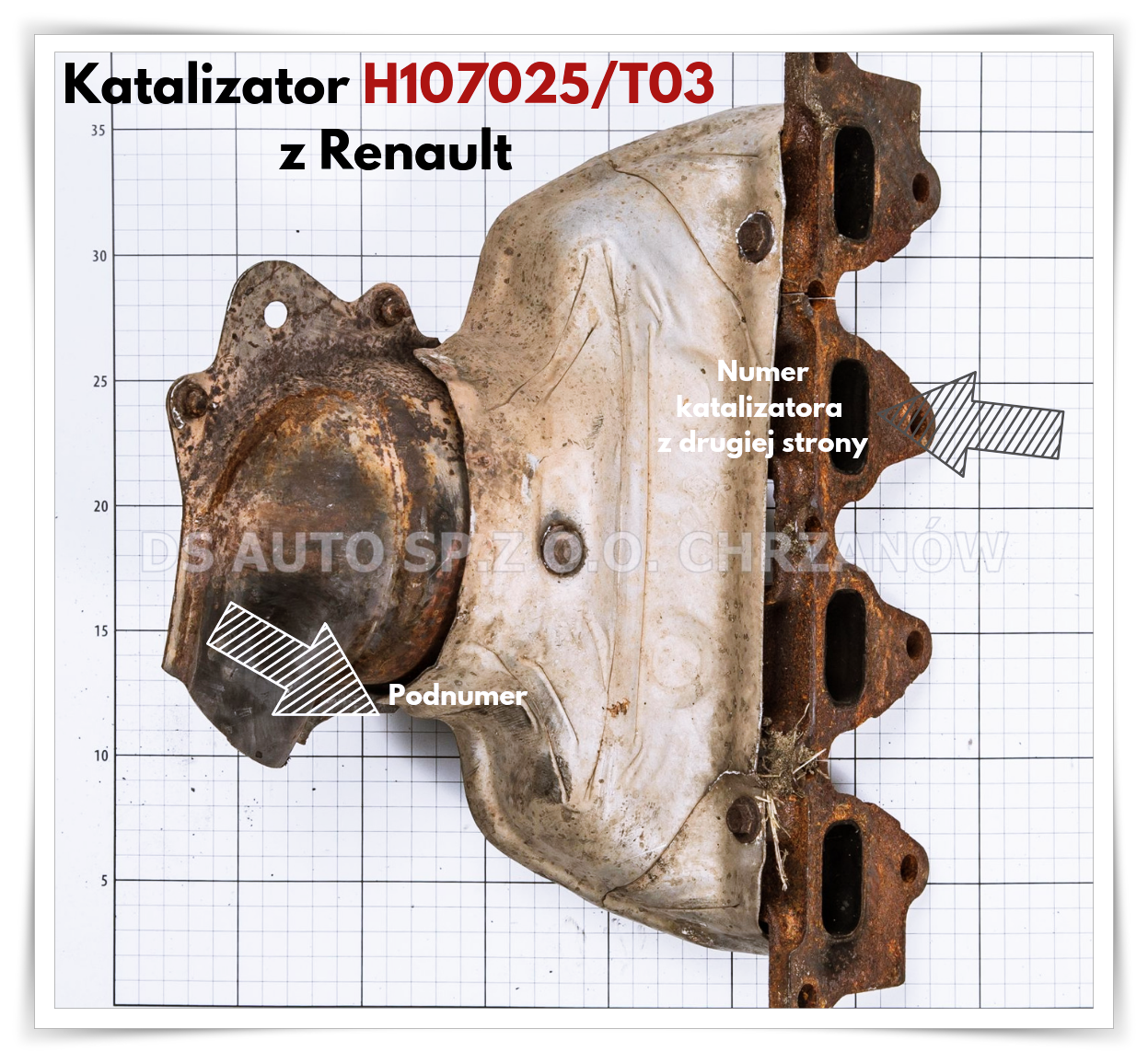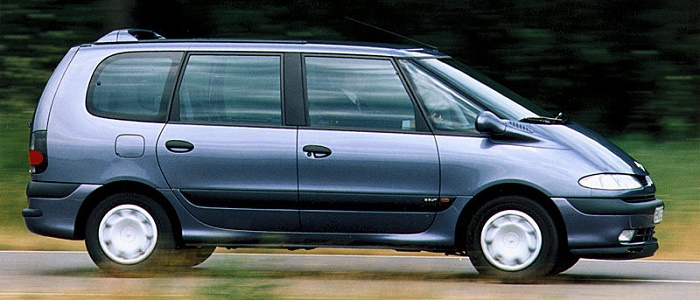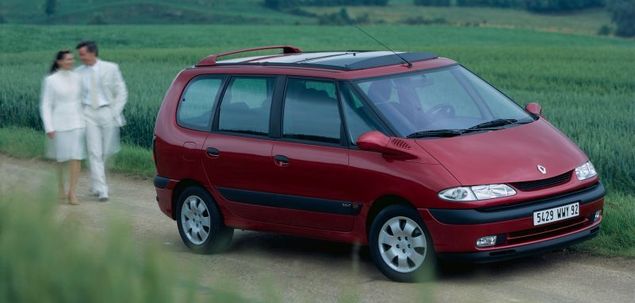Catalyst H107025/T03 it was mounted in 1997-2003 to brand cars Renault. This reactor is available in models Renault Laguna, Megane, Scenic and Espace in the petrol version, with 1.6, 1.8, 2.0 engines.
This collector catalyst is characterized by an oval shape and a small size. Its weight is relatively low and amounts to 0.27 kg, and the length of this device is about 40 cm. In our purchase for this catalyst you will get a price up to 32% higher compared to competitive prices.
You can check the price of this model outside the promotion here.

Today, we look at the car that became famous as the first family vehicle in Europe – Renault Espace.
The inspiration and idea to create the Espace car was the excitement of American van. The first minivan car was Chrysler Voyager, which inspired subsequent concerns, starting from Renault in Europe, to create a fully practical car.
The main concept was to create a large and spacious car (hence the name of the ESPACE model – space) that allows traveling in comfortable conditions, especially when it comes to large families. It is not difficult to imagine that the launch of a single-body vehicle will be doomed to success for many years.
The first works and production of Renault Espace cars began in 1984-1991 in cooperation with Renault and Mantra.
Although only 9 models were sold in the first month, consumers quickly realized the benefits of having an MPV.

The large size, sharp shapes of the car, front, oblique lights with orange housing, as well as the heavily glazed passenger compartment are the distinguishing features of the first version of the 1984 Espace model.
In 1988, the Espace model underwent a delicate facelift, in which the headlights were changed, the older version was replaced by inclined lights with a clear indicator housing.
A significant change was the introduction of the four-wheel drive model called Quadra.
The huge success of the car can be seen from the violations of Renault’s intellectual property rights along with the copy of the pioneering Espace model in Brazil by Ford Grancar and Toni Bianco under its own name Grancar Futura. Of course, for known reasons, the brand did not achieve its goals, only 159 vehicles with this name were produced, and in 1991 the production of Futura came to an end.
ESPACE II
The next production of the upgraded version of the minivan began in January 1991. Seven years after the first model was launched, it was time for a completely new design. The vehicle increased its length, the Renault 25 design was used for the front suspension system, the appearance of the dashboard was changed, a new gasoline engine with a capacity of 2.85 l and 150 hp was introduced, the new look also concerned the fitting of seats with headrests.
To celebrate the 10th anniversary of the flagship monobloc production, Renault presented the Espace F1 to celebrate the tenth anniversary of Espace and Renault’s commitment to Formula One racing.
The Espace F1 had 800 hp. The engine and transmission allowed acceleration from 0-100 km in 2.8 seconds, from 0-200 km in 6.9 seconds, and the maximum speed of this car is 312 km / h.
The sports appearance of the car was influenced by the changed appearance of the body, as well as the use of carbon fiber in the chassis in combination with the Espace Carbon body.
Currently, the anniversary car model can be seen at the Matra Museum in France.
The next, third version of the Espace car was produced in the years 1996-2002, it was in this version of the model that the catalyst H107025 was used , about which this article is.

The third generation of the Renault family model appeared in December 1996. In these years, Renault Espace already has a lot of well-organized competitors. This generation is a step towards the future. The futuristic appearance provides a changed car interior, among others elongated and centrally mounted dashboard, digital speedometer and radio, as well as a built-in CD display. In 1997, an enlarged model called Grand appeared, which began to introduce a long wheelbase, thus providing the ability to accommodate up to 7 people in the car.
By 2002, 365 200 models were produced.
In the years 2002-2014, the fourth generation of the model appeared, which beat the competitors. In November 2002 a completely refined Renault Espace model appeared. The style that was expressed in the 4th generation of this model gave a new direction to the design of Renault cars. The model produced in those years in 90 percent. consisted of recyclable materials. The car has numerous materials that reduce weight, which definitely contributed to the economy of the car by reducing fuel consumption. The radical change of stylization referring to the models Vel Satis and Avantime caused that the Espace model reached a higher level.
Renault Espace in the 4th generation has undergone three phases of facelift changes.
The first of them was made in 2006, where the product offer was enriched with models with 2.0 and 3.0 liters dCi engines.
Another modernization was carried out in 2010, where small external changes of the car, LED lighting, as well as improved interior equipment were presented.
The final phase of the transformation of the fourth generation of the model was aimed at introducing changes that would meet the French regulations on CO2 emissions. To this end, new dCi 2.0 engines have been introduced. The change in style of the car was supposed to refer to the concept of the “family feeling” project, as the name implies, the assumption of the design was a sense of comfort and safety of families while driving. In safety tests Euro NCAP received 5 stars for adults and 2 for pedestrians.
The Renault Espace IV generation has received many positive reviews and is described as one of the best vehicles in the large MPV class.
Currently, you can buy the V generation model on the world market, which went on sale in 2014. What makes it special is, above all, the fact that it is no longer a large minivan car, and instead takes the form of a medium-size luxury crossover.
There is no doubt that the purpose of this car is to combine the properties of SUV and VAN.
The architecture of the car is based on vehicles from the Renault-Nissan Common Modul family developed by Renault and Nissan.
The latest Espace model offers a modern version of the Renault R Link 2 information system, has voice control, built-in navigation, radio with bluetooth function, emergency braking support, lane departure warning and recognizable road signs with speed limit alerts. Renault Espace V generation also has radar adaptive cruise control and active emergency braking.
The information system has 360-degree sensors, a built-in camera allows hands-free reversing and parking.
Espace also has several disadvantages that are worth paying attention to.
You can often get an opinion on the falling electronics in the car. The most common problems are related to the code card that makes it possible to start the vehicle. The first signs of defects are sporadic, but from the beginning it is worth paying attention to small things, because neglect can lead to complete immobilization of the vehicle. The cost of buying a new card is around PLN 1000, and repairing it is around PLN 100-150. It is not worth delaying.
Despite the disadvantages in electricity, vehicles are popular. Their 35-year presence on the market is the greatest proof of this.

 Phone number:
Phone number:  E-mail:
E-mail:  A stationary point:
A stationary point:  Getting from the customer:
Getting from the customer:  XRF analysis spectrometer:
XRF analysis spectrometer:  Valuation by numbers:
Valuation by numbers: 